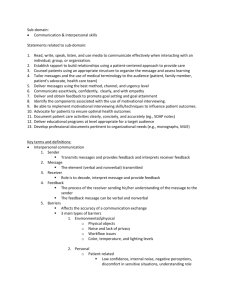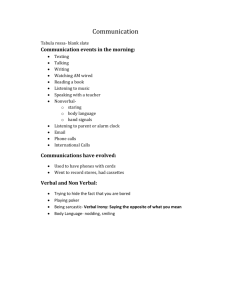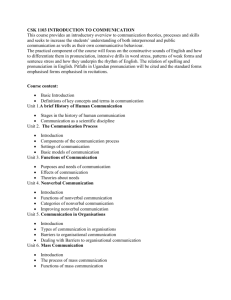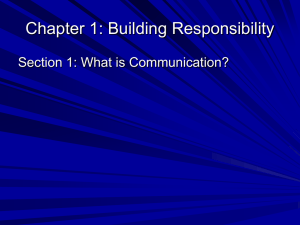chapter 2 multicultural and global communication
advertisement
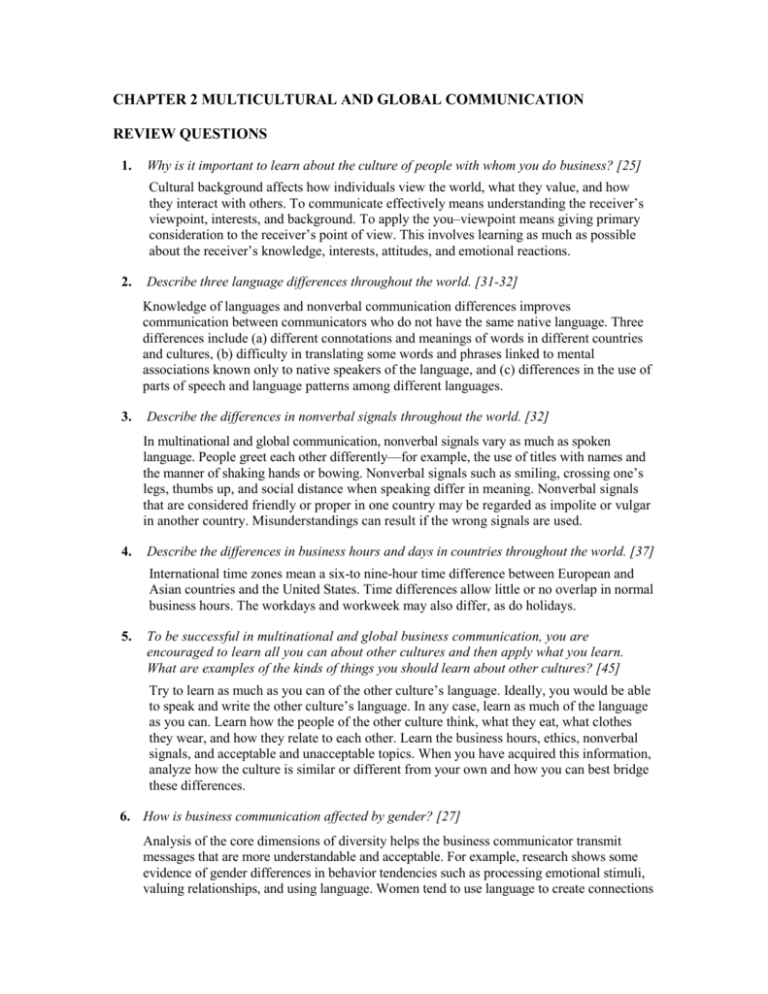
CHAPTER 2 MULTICULTURAL AND GLOBAL COMMUNICATION REVIEW QUESTIONS 1. Why is it important to learn about the culture of people with whom you do business? [25] Cultural background affects how individuals view the world, what they value, and how they interact with others. To communicate effectively means understanding the receiver’s viewpoint, interests, and background. To apply the you–viewpoint means giving primary consideration to the receiver’s point of view. This involves learning as much as possible about the receiver’s knowledge, interests, attitudes, and emotional reactions. 2. Describe three language differences throughout the world. [31-32] Knowledge of languages and nonverbal communication differences improves communication between communicators who do not have the same native language. Three differences include (a) different connotations and meanings of words in different countries and cultures, (b) difficulty in translating some words and phrases linked to mental associations known only to native speakers of the language, and (c) differences in the use of parts of speech and language patterns among different languages. 3. Describe the differences in nonverbal signals throughout the world. [32] In multinational and global communication, nonverbal signals vary as much as spoken language. People greet each other differently—for example, the use of titles with names and the manner of shaking hands or bowing. Nonverbal signals such as smiling, crossing one’s legs, thumbs up, and social distance when speaking differ in meaning. Nonverbal signals that are considered friendly or proper in one country may be regarded as impolite or vulgar in another country. Misunderstandings can result if the wrong signals are used. 4. Describe the differences in business hours and days in countries throughout the world. [37] International time zones mean a six-to nine-hour time difference between European and Asian countries and the United States. Time differences allow little or no overlap in normal business hours. The workdays and workweek may also differ, as do holidays. 5. To be successful in multinational and global business communication, you are encouraged to learn all you can about other cultures and then apply what you learn. What are examples of the kinds of things you should learn about other cultures? [45] Try to learn as much as you can of the other culture’s language. Ideally, you would be able to speak and write the other culture’s language. In any case, learn as much of the language as you can. Learn how the people of the other culture think, what they eat, what clothes they wear, and how they relate to each other. Learn the business hours, ethics, nonverbal signals, and acceptable and unacceptable topics. When you have acquired this information, analyze how the culture is similar or different from your own and how you can best bridge these differences. 6. How is business communication affected by gender? [27] Analysis of the core dimensions of diversity helps the business communicator transmit messages that are more understandable and acceptable. For example, research shows some evidence of gender differences in behavior tendencies such as processing emotional stimuli, valuing relationships, and using language. Women tend to use language to create connections and relationships; whereas, men tend to use language to assert independence and maintain group position. In decision making, women are likely to discuss a problem with others and seek input, but men may believe it is their job to make decisions without input. Another important issue pertinent to gender is that of sexual harassment. Business communication between the sexes calls for a clear understanding of remarks and actions that could make the receiver uncomfortable or intimidated and be construed as sexual harassment. Understanding perceptual differences of both genders can improve communication. 7. Explain three basic guidelines for multicultural business communication. [33-34] Review business communication principles. This means achieving a shared meaning between sender and receiver, achieving an appropriate response, and building goodwill. Other principles include analyzing the receiver, using the you–viewpoint, selecting the appropriate form of message, providing feedback, and removing communication barriers. Understand your own culture. Know your own culture and how others view your culture. Awareness of your own culture is the first step to understanding and communicating with other cultures. Keep an open mind and respect diversity. Understand that how people believe and do things in your culture is not the only way. Learn about other cultures and be open to different ways of doing things. Be understanding and respectful of differences. Identify and adapt to language differences. Learn as much as you can about the language. Ata minimum,learn greetings, courtesy words, and nonverbal positive and negative signals. Learn a few basic phrases and learn about the people of that culture. Learn how people relate to each other, their food and apparel preferences, the hours of their workday and days for their workweek, negotiation style, business ethics, and acceptable and unacceptable differences. Understand that people whose native language is not English have differing degrees of facility with the language and that their understanding will govern communication effectiveness.

